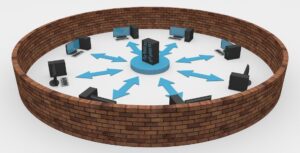
Defining the New ‘Workforce Ecosystem’
Pam Sornson, JD
March 7, 2023
‘Human Capital.’ ‘Talent Management.’ ‘Employee Experience.’ ‘DEI.’ ‘Critical Skills.’ ‘Work Models.’ ‘Contingent Workers.’ While these individual terms are now familiar to most business leaders, they are coming together these days in a new configuration. They are being used to describe an emerging philosophy of workforce administration. Conventional practices no longer serve the needs of either employers or employees. Instead, as the pandemic recedes and new business habits materialize, optimal productivity mandates embracing the whole spectrum of worker capacity and utilizing those unsung resources to build a better workforce and a better community.

Business as Not Usual
The work world is evolving away from ‘one-size-fits-all staff management’ practices (typically time clocks, ‘regular hours,’ paid time off, etc.). Instead, tomorrow’s employment professionals are discussing the aspects of a new ‘workforce ecosystem‘ concept that embraces the shift away from ‘work-a-day’ norms and toward happier, more enlightened ‘productivity assets.’
Several factors are driving these innovative developments in workforce management, many of which were triggered during the COVID-19 era and most of which appear to be inevitable anyway, given the swift advance of technology.
Labor Force Factors
Three elements in particular drive evolving expectations in the labor sector:
The absence of available workers – The pandemic didn’t just force thousands of people from their jobs. It also drove thousands of others to quit intentionally. And despite significant job growth in the past two years, the country is still struggling to get work done, with three million fewer workers on shift compared to February 2020. The impact of those labor gaps is felt in every industry because businesses can’t compete, grow, or thrive without a fully functioning workforce in place.
The rise of ‘worker agency’ – Almost three years of global economic disruptions have dramatically changed the employer/employee relationship. In many instances, a dwindling labor pool transferred power over employment details from the boss – who needs workers – to the worker, who has little, if any, competition for the job. Consequently, incoming staff have a stronger voice with corporate leadership regarding wage rates, working conditions, and enhanced opportunities for bonuses and promotions.
Generational challenges – The era of spending a lifetime in a single career is ending as the baby boomer generation ages out of the workforce. Not only is there no population of any size to fill in those gaps, but those subsequent generations – the Millennials, Gen Z, and now Generation Alpha – together are smaller than the boomer group, and they have a decidedly different perspective on the meaning of ‘work’ and how they want to pursue their careers.
Marketplace Factors
The nature of work is also changing rapidly. Companies are struggling to adapt traditional methods and assets to emerging opportunities, even when those promise greater profitability and success.
Technology has completely eliminated some jobs while making many others distinctly more complex. The capacity for staff to work remotely adds unprecedented flexibility for both company and worker while also adding layers of management needed to oversee the associated risks and logistics.
‘Skills-based’ occupations have replaced ‘job title’ postings for many companies. Hirers are looking for qualified workers who have the skills needed for the job, so potential hires are prioritizing their skillsets over their past employment positions. In some cases, a worker well-skilled in critical activities is more valuable to the corporation than a less skilled but ‘better educated’ colleague. The deviation toward skills and away from book learning as the fundamental training format is engaging new work and career options among those workers who might not have pursued a job at all.
The need for agility is also becoming more significant for corporate success. Today’s markets move faster than ever, and new, competitive products and services are introduced daily. Keeping up with the competition is imperative to organizational survival, and having a staff that is capable of adapting swiftly to marketplace changes is equally critical.

Think Outside the Cubical
Looking ahead, today’s business leaders should be contemplating how they can improve their organization’s productivity in three years, five years, or a decade. That new iteration will almost certainly not look like today’s conventional ‘business’ configuration. But it should not look like an unorganized mishmash of traditional and innovative work management styles, either.
Instead, today’s leaders can strategize through the chaos to an enlightened and energized new enterprise by addressing and overcoming the two biggest hurdles to growth – an unprepared corporate culture and entrenched, inefficient work processes.
The management ‘mindset’ should be the first target for innovation. The corporate culture will transition into its new, more fluid configuration when managers intend to lead it there. This new workforce management strategy will require ‘executive control’ to shift from ‘direction’ to ‘orchestration.’ Rather than marshaling workers and their individual efforts, leaders at all levels of the organization should think of orchestrating the aggregated outputs of those human resource assets to achieve corporate goals.
Eliminate the now obsolete ‘job title’ composition of labor hierarchy and embrace the “workforce ecosystem” mindset as the new “workforce development strategy.” This ecosystem can be whatever the organization requires; it is essentially ‘boundaryless’ in that it incorporates and values the contributions of all workers, regardless of their title, role, or worker status.
Establish an open workforce objective that emphasizes skills and contributions over traditional ‘laborer’ metrics and provides the support that each worker needs to be successful, whether they are full-time employees, contractors, or some other form of paid contributors to enterprise success.
These days, employees want – and can command – better recognition for the individual skills and abilities they bring to their job. Companies that do well at satisfying these newly identified requirements can harness those added values into a corporate ecosystem that builds both a better business and a better community.


